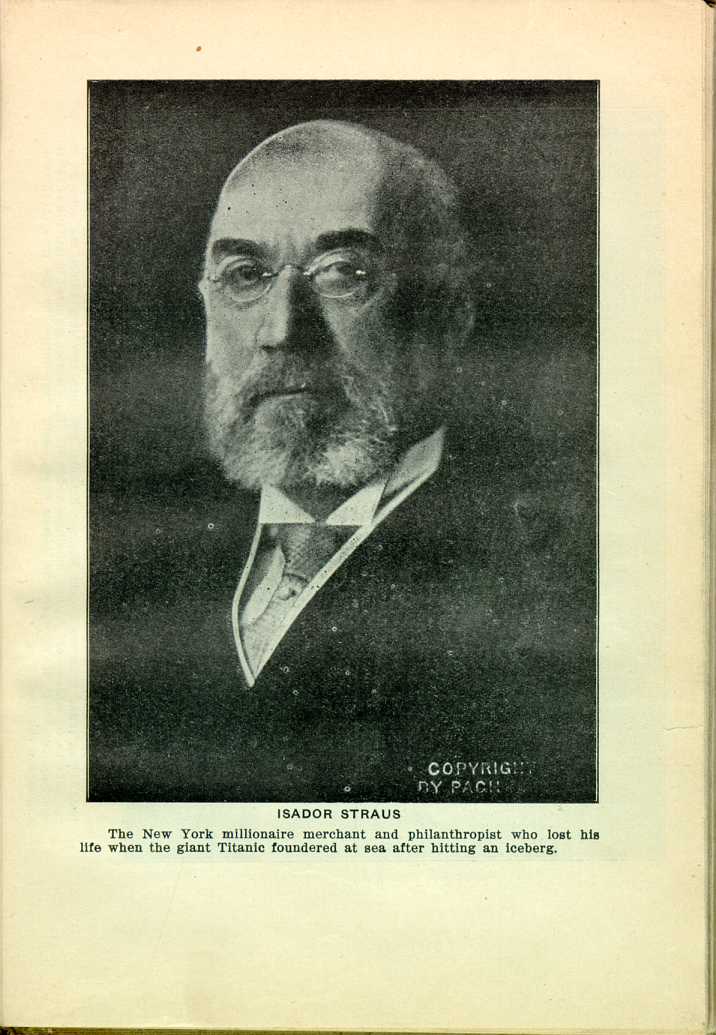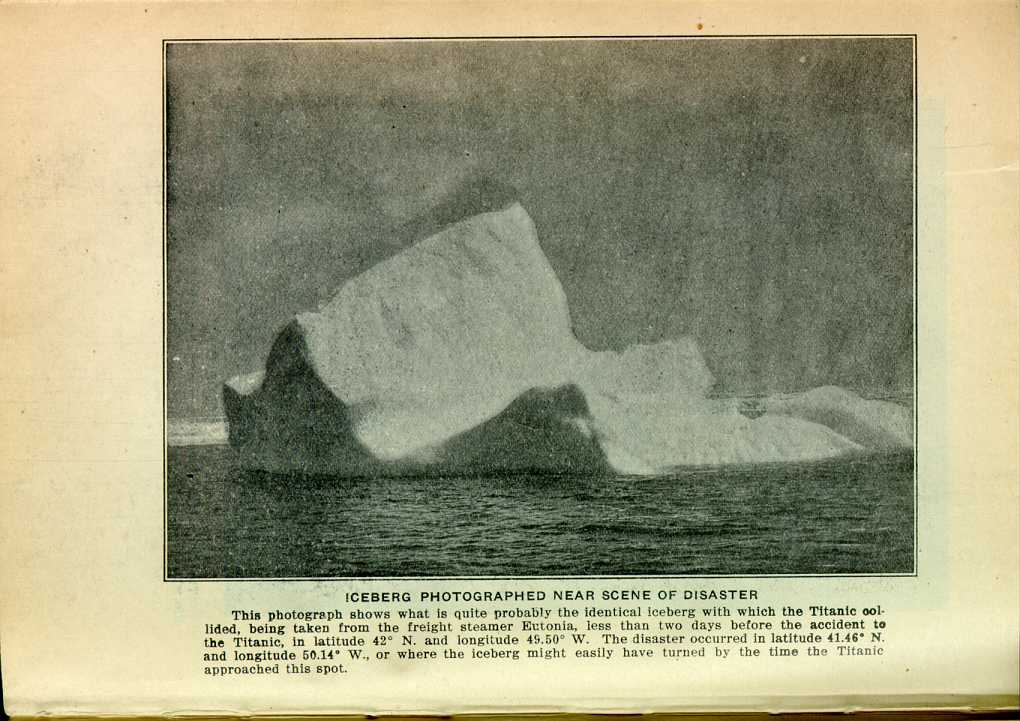21.
CHAPTER XXI
SEARCHING FOR THE DEAD
SENDING OUT THE MACKAY-BENNETT AND MINIA—BREMEN
PASSENGERS SEE BODIES—IDENTIFYING BODIES—CONFUSION
IN NAMES—RECOVERIES
A FEW days after the disaster the cable steamer Mackay-Bennett was sent out by the White Star Line to cruise in the vicinity of the disaster and search for missing bodies.
Two wireless messages addressed to J. Bruce Ismay, president of the International Mercantile Marine Company, were received on April 21st at the offices of the White Star Line from the cable ship Mackay-Bennett, via Cape Race, one of which reported that the steamship Rhein had sighted bodies near the scene of the Titanic wreck. The first message, which was dated April 20th, read:
"Steamer Rhein reports passing wreckage and bodies 42.1
north, 49.13 west, eight miles west of three big icebergs. Now
making for that position. Expect to arrive 8 o'clock to-night.
(Signed) "MACKAY-BENNETT."
The second message read:
"Received further information from Bremen (presumably
steamship Bremen) and arrived on ground at 8 o'clock P. M.
Start on operation to-morrow. Have been considerably
delayed on passage by dense fog.
(Signed) "MACKAY-BENNETT."
After receiving these messages Mr. Ismay issued the following statement:
"The cable ship Mackay-Bennett has been chartered by the White Star Line and ordered to proceed to the scene of the disaster and do all she could to recover the bodies and glean all information possible.
"Every effort will be made to identify bodies recovered, and any news will be sent through immediately by wireless. In addition to any such message as these, the Mackay-Bennett will make a report of its activities each morning by wireless, and such reports will be made public at the offices of the White Star Line.
"The cable ship has orders to remain on the scene of the wreck for at least a week, but should a large number of bodies be recovered before that time she will return to Halifax with them. The search for bodies will not be abandoned until not a vestige of hope remains for any more recoveries.
"The Mackay-Bennett will not make any soundings, as they would not serve any useful purpose, because the depth where the Titanic sank is more than 2000 fathoms."
On April 22d the first list of twenty-seven names of bodies recovered was made public. It contained that of Frederick
The wireless message, after listing the names, concluded, "All preserved," presumably referring to the condition of the bodies.
A number of the names in the list did not check up with the Titanic's passenger list, which led to the belief that a number of the bodies recovered were members of the Titanic's crew.
MINIA SENT TO ASSIST
At noon, April 23d, there was posted on the bulletin in the White Star office this message from the Mackay-Bennett dated Sunday, April 21st:
"Latitude, 41.58; longitude, 49.21. Heavy southwest swell has interfered with operations. Seventy-seven bodies recovered. All not embalmed will be buried at sea at 8 o'clock to-night with divine service. Can bring only embalmed bodies to port."
To Captain Lardner, master of the Mackay-Bennett, P. A. S. Franklin, vice-president of the White Star Line, sent an urgent message asking that the company be advised at
Mr. Franklin then directed A. G. Jones, the Halifax agent of the White Star Line, to charter the Minia and send her to the assistance of the Mackay-Bennett. Mr. Jones answered this telegram, and said that the Minia was ready to proceed to sea, but that a southeast gale, which generally brings fog, might delay her departure. She left for Halifax.
NAMES BADLY GARBLED
On April 24th no wireless message was received from the Mackay-Bennett, but the White Star Line officials and telegraphers familiar with the wireless alphabet were busy trying to reconcile some of the names received with those of persons who went down on the Titanic. That the body of William T. Stead, the English journalist and author, had been recovered by the Mackay-Bennett, but through a freakish error in wireless transmission the name of another was reported instead, was one of the theories advanced by persons familiar with the Morse code.
BREMEN SIGHTED MORE THAN A HUNDRED BODIES
When the German liner Bremen reached New York the account of its having sighted bodies of the Titanic victims was obtained.
From the bridge, officers of the ship saw more than a hundred
In the vicinity was seen an iceberg which answered the description of the one the Titanic struck. Smaller bergs were sighted the same day, but at some distance from where the Titanic sank.
The officers of the Bremen did not care to talk about the tragic spectacle, but among the passengers several were found who gave accounts of the dismal panorama through which their ship steamed.
Mrs. Johanna Stunke, a first-cabin passenger, described the scene from the liner's rail.
"It was between 4 and 5 o'clock, Saturday, April 20th," she said, "when our ship sighted an iceberg off the bow to the starboard. As we drew nearer, and could make out small dots floating around in the sea, a feeling of awe and sadness crept over everyone on the ship.
"We passed within a hundred feet of the southernmost drift of the wreckage, and looking down over the rail we distinctly saw a number of bodies so clearly that we could make out what they were wearing and whether they were men or women.
"We saw one woman in her night dress, with a baby clasped closely to her breast. Several women passengers screamed
"The bodies of three men in a group, all clinging to one steamship chair, floated near by, and just beyond them were a dozen bodies of men, all of them encased in life-preservers, clinging together as though in a last desperate struggle for life. We couldn't see, but imagined that under them was some bit of wreckage to which they all clung when the ship went down, and which didn't have buoyancy enough to support them.
"Those were the only bodies we passed near enough to distinguish, but we could see the white life-preservers of many more dotting the sea, all the way to the iceberg. The officers told us that was probably the berg hit by the Titanic, and that the bodies and ice had drifted along together."
Mrs. Stunke said a number of the passengers demanded that the Bremen stop and pick up the bodies, but the officers assured them that they had just received a wireless message saying the cable ship Mackay-Bennett was only two hours away from the spot, and was coming for that express purpose.
Other passengers corroborated Mrs. Stunke.
THE IDENTIFIED DEAD.
On April 25th the White Star Line officials issued a corrected list of the identified dead. While the corrected list cleared up two or more of the wireless confusions that caused so much speculation in the original list, there still remained a
The new list, however, established the fact that the body of George D. Widener, of Philadelphia, was among those on the Mackay-Bennett, and two of the bodies were identified as those of men named Butt.
THE MACKAY-BENNETT RETURNS TO PORT
After completing her search the Mackay-Bennett steamed for Halifax, reaching that port on Tuesday, April 30th. With her flag at half mast, the death ship docked slowly. Her crew manned the rails with bared heads, and on the aft deck were stacked the caskets with the dead. The vessel carried on board 190 bodies, and announcement was made that 113 other bodies had been buried at sea.
Everybody picked up had been in a life-belt and there were no bullet holes in any. Among those brought to port were the bodies of two women.
THE MINIA GIVES UP THE SEARCH
When at last the Minia turned her bow toward shore only thirteen additional bodies had been recovered, making a total of 316 bodies found by the two ships.
Further search seemed futile. Not only had the two vessels gone thoroughly over as wide a field as might likely prove fruitful, but, in addition, the time elapsed made it improbable that other bodies, if found, could be brought to shore. Thus did the waves completely enforce the payment of their terrible toll.
LIST OF IDENTIFIED DEAD
Following is a list of those whose identity was wholly or partially established:
- ASTOR, JOHN JACOB.
- ADONIS, J.
- ALE, WILLIAM.
- ARTAGAVEYTIA, RAMON.
- ASHE, H. W.
- ADAHL, MAURITZ.
- ANDERSON, THOMAS.
- ADAMS, J.
- ASPALANDE, CARL.
- ALLEN, H.
- ANDERSON, W. Y.
- ALLISON, H. J.
- BUTT, W. (seaman).
- BUTT, W. (may be Major Butt).
- BUTTERWORTH, ABELJ.
- BAILEY, G. F.
- BARKER, E. T.
- BUTLER, REGINALD.
- BIRNBAUM, JACOB.
- BRISTOW, R. C.
- BUCKLEY, KATHERINE.
- CHAPMAN, JOHN H.
- CHAPMAN, CHARLES.
- CONNORS, P.
- CLONG, MILTON.
- COX, DENTON.
- CAVENDISH, TYRRELL W.
- CARBINES, W.
- DUTTON, F.
- DASHWOOD, WILLIAM.
- DULLES, W. C.
- DOUGLAS, W. D.
- DRAZENOUI, YOSIP (referring probably to Joseph Draznovic).
- DONATI, ITALO (waiter).
- ENGINEER, A. H. F.
- ELLIOTT, EDWARD.
- FARRELL, JAMES.
- FAUNTHORPE, H.
- GILL, J. H.
- GREENBERG, H.
- GILINSKI, LESLIE.
- GRAHAM, GEORGE.
- GILES, RALPH.
- GIVARD, HANS C.
- HANSEN, HENRY D.
- HAYTOR, A.
- HAYS, CHALES M.
- HODGES, H. P.
- HELL, J. C.
- HEWITT, T.
- HARRISON, H. H.
- HALE, REG.
- HENDEKERIC, TOZNAI.
- HINTON, W.
- HARBECK, W. H.
- HOLVERDON, A. O. (probably A. M. Halverson of Troy).
- HOFFMAN, LOUIS M.
- HINCKLEY, G.
- Hospital Attendant, no name given.
- JOHANSEN, MALCOLM.
- JOHANSEN, ERIC.
- JOHANSSON, GUSTAF J.
- JOHANSEN, A. F.
- JONES, C. C.
- KELLY, JAMES,
- LAURENCE, A.
- LOUCH, CHARLES.
- LONG, MILTON C.
- LILLY, A.
- LINHART, WENZELL.
- MARRIORTT, W. H. (no such name appears on the list of passengers or crew).
- MANGIN, MARY.
- McNAMEE, MRS. N. (probably Miss Elleen McNamee.)
- MACK, MRS.
- MONROE, JEAN.
- McCAFFRY, THOMAS.
- MORGAN, THOMAS.
- MOEN, SEGURD H.
- NEWELL, T. H.
- NASSER, NICOLAS.
- NORMAN, ROBERT D.
- PETTY, EDWIN H.
- PARTNER, AUSTIN.
- PENNY, OLSEN F.
- POGGI, —.
- RAGOZZI, A. BOOTHBY.
- RICE, J. R.
- ROBINS, A.
- ROBINSON, J. M.
- ROSENSHINE, GEORGE.
- STONE, J.
- STEWARD, 76.
- STOKES, PHILIP J.
- STANTON, W.
- STRAUS, ISIDOR.
- SAGE, WILLIAM.
- SHEA, —.
- SUTTON, FREDERICK.
- SOTHER, SIMON.
- SCHEDID, NIHIL.
- SWANK, GEORGE.
- SEBASTIANO, DEL CARLO.
- STANBROCKE, A.
- TOMLIN, ETNEST P.
- TALBOT, G.
- VILLNER, HENDRICK K.
- VASSILIOS, CATALEVAS (thought to be a confusion of two surnames).
- VEAR, W. (may be W. J. Ware or W. T. Stead).
- WIDENER, GEORGE W.
- WILLIAMS, LESLIE.
- WIRZ, ALBERT
- WIKLUND, JACOB A.
- WAILENS, ACHILLE.
- WHITE, F. F.
- WOODY, O. S.
- WERSZ, LEOPOLD.
- ZACARIAN, MAURI DER.

